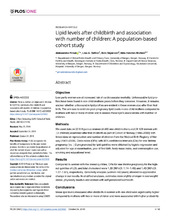| dc.contributor.author | Pirnat, Aleksandra | en_US |
| dc.contributor.author | deRoo, Lisa | en_US |
| dc.contributor.author | Skjaerven, Rolv | en_US |
| dc.contributor.author | Morken, Nils-Halvdan | en_US |
| dc.date.accessioned | 2020-05-11T08:12:23Z | |
| dc.date.available | 2020-05-11T08:12:23Z | |
| dc.date.issued | 2019-10-24 | |
| dc.Published | Pirnat A, deRoo L, Skjaerven R, Morken N. Lipid levels after childbirth and association with number of children: A population-based cohort study. PLOS ONE. 2019;14(10): e0223602 | eng |
| dc.identifier.issn | 1932-6203 | |
| dc.identifier.uri | https://hdl.handle.net/1956/22171 | |
| dc.description.abstract | Objective Low parity women are at increased risk of cardiovascular mortality. Unfavourable lipid profiles have been found in one-child mothers years before they conceive. However, it remains unclear whether unfavourable lipid profiles are evident in these women also after their first birth. The aim was to estimate post-pregnancy lipid levels in one-child mothers compared to mothers with two or more children and to assess these lipid’s associations with number of children. Methods We used data on 32 618 parous women (4 490 one-child mothers and 28 128 women with ≥2 children) examined after first childbirth as part of Cohort of Norway (1994–2003) with linked data on reproduction and number of children from the Medical Birth Registry of Norway (1967–2008). Odds ratios (ORs) with 95% confidence intervals (CIs) for one lifetime pregnancy (vs. ≥2 pregnancies) by lipid quintiles were obtained by logistic regression and adjusted for age at examination, year of first birth, body mass index, oral contraceptive use, smoking and educational level. Results Compared to women with the lowest quintiles, ORs for one lifetime pregnancy for the highest quintiles of LDL and total cholesterol were 1.30 (95%CI: 1.14–1.45) and 1.43 (95%CI: 1.27–1.61), respectively. Sensitivity analysis (women <40 years) showed no appreciable change in our results. In stratified analyses, estimates were slightly stronger in overweight/obese, physically inactive and women with self-perceived bad health. Conclusions Mean lipid levels measured after childbirth in women with one child were significantly higher compared to mothers with two or more children and were associated with higher probability of having only one child. These findings corroborate an association between serum lipid levels and one lifetime pregnancy (as a feature of subfecundity), emphasizing that these particular women may be a specific predetermined risk group for cardiovascular related disease and death. | en_US |
| dc.language.iso | eng | eng |
| dc.publisher | PLoS | eng |
| dc.rights | Attribution CC BY | eng |
| dc.rights.uri | https://creativecommons.org/licenses/by/4.0 | eng |
| dc.title | Lipid levels after childbirth and association with number of children: A population-based cohort study | en_US |
| dc.type | Peer reviewed | |
| dc.type | Journal article | |
| dc.date.updated | 2019-12-20T11:34:31Z | |
| dc.description.version | publishedVersion | en_US |
| dc.rights.holder | Copyright 2019 Pirnat et al. | |
| dc.identifier.doi | https://doi.org/10.1371/journal.pone.0223602 | |
| dc.identifier.cristin | 1748381 | |
| dc.source.journal | PLoS ONE | |

